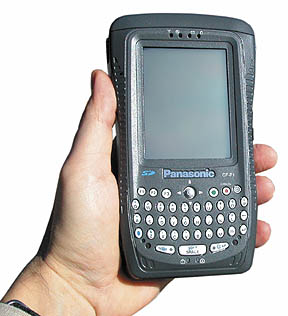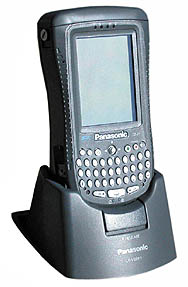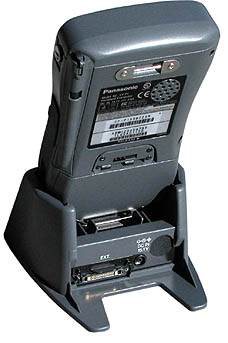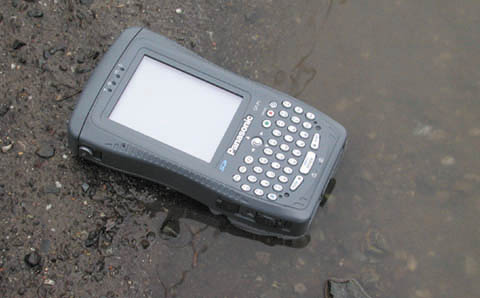

Current Cover
Recent issues






|
|
|
|
|
|
Panasonic Toughbook 01A wireless handheld as tough as they come (May 2002 issue)by Conrad Blickenstorfer  The brand name "Panasonic" conjures up images of
a wide variety of consumer electronics products ranging from cameras to audio
equipment to microwaves to phones and TV sets. Panasonic's parent Matsushita is a
global giant with some 70 billion US$ in sales in four major areas:
audio/video/communications, home appliances, industrial equipment, and components
and devices. Readers of Pen Computing Magazine know Panasonic primarily for the
name the company has made for itself over the past several years with its
"Toughbook" line of ruggedized notebook computers. The whole Toughbook idea got
started when some bright person realized that while notebook computers
represented a very lucrative and rapidly growing market, conventional notebooks
simply weren't built tough enough to take a beating. A beating as in being tossed
onto the back seat of a car, used on an airplane or on the road, or simply handle
day-to-day use. Panasonic commissioned some studies of notebook usage and
performance and found sobering damage rates and related repair and maintenance
cost. So they decided to build tougher notebooks--Toughbooks. The brand name "Panasonic" conjures up images of
a wide variety of consumer electronics products ranging from cameras to audio
equipment to microwaves to phones and TV sets. Panasonic's parent Matsushita is a
global giant with some 70 billion US$ in sales in four major areas:
audio/video/communications, home appliances, industrial equipment, and components
and devices. Readers of Pen Computing Magazine know Panasonic primarily for the
name the company has made for itself over the past several years with its
"Toughbook" line of ruggedized notebook computers. The whole Toughbook idea got
started when some bright person realized that while notebook computers
represented a very lucrative and rapidly growing market, conventional notebooks
simply weren't built tough enough to take a beating. A beating as in being tossed
onto the back seat of a car, used on an airplane or on the road, or simply handle
day-to-day use. Panasonic commissioned some studies of notebook usage and
performance and found sobering damage rates and related repair and maintenance
cost. So they decided to build tougher notebooks--Toughbooks.
The ToughbooksThe rest is history. The Panasonic Personal Computer Company set out to build a whole lineup of ruggedized notebooks that combined durability with good looks and the high performance demanded by the market. Starting basically from scratch just a few years ago, the Toughbook guys now sell some $350 million worth of finely tuned computer gear in the US. They changed their name to the Panasonic Computer Solutions Company in order to reflect their strategy of not just selling boxes but solutions to clients who use notebooks outside of the office. Some of those clients buy Toughbooks in bulk quantities. SBC deployed 33,000 and British Telecom 30,000 CF-27 models equipped with line testing modules in their multimedia bays.Since Panasonic's target markets have many different requirements, each Toughbook model is highly configurable, and Panasonic has also added some new, innovative form factors to their lineup. One was the PDRC (Permanent Display Removable Computer), a notebook with a detachable display that wirelessly communicated with the rest of the notebook. That concept was refined into the Toughbook 07, which again consists of a separate display module that communicates with a base station. The 07's base station, however, is shaped like a small brick and can be mounted in a car, on a bike, or even worn in a body harness (see full review on page 40 of this issue).
The Toughbook 01 HandheldThe only thing missing from Panasonic's lineup was a true handheld. Not anymore. The new Toughbook 01 model shown here is meant to fill that role. Its full name is the Panasonic Toughbook customizable wireless handheld PC CF-P1. In this case, of course, the "Toughbook" name is a bit of a misnomer because the 01 really looks and feels like a ruggedized Pocket PC. Its PDA form factor, the portrait-oriented display, and its overall design reveal it to be a high tech replacement of a traditional handheld terminal rather than a notebook replacement. Nothing wrong with that at all. There are many areas where even a small notebook or tablet is simply too large and all that's needed is the industrial equivalent of a PDA. That's what the 01 is.But it is not just any PDA and it also is also not just a hardened Pocket PC. In fact, it is not a Pocket PC at all. While the 01 employs the same speedy 206MHz Intel SA 1110 processor common to all new Pocket PCs, and while it uses the same 3.5-inch reflective color TFT display seen in Pocket PCs, the 01 is actually an embedded Windows CE device. It uses Windows CE 3.0 as its core OS and some basic utilities and applications common to most CE devices (such as IE Explorer or the Control Panel), but most customers will develop and use their own specialized applications.
Superb designFrom a design point of view, the 01 is an absolutely superb product. The dark-gray body is entirely made of a magnesium alloy and exudes the same aura of trust-inspiring rugged elegance that I like so much in my Nikon Coolpix 990 digital camera. The body of the 01 is significantly larger than that of a typical consumer market Pocket PC such as the Compaq iPAQ, but it is ergonomically designed and fits perfectly into your hand. Every detail is practical,
functional, yet beautifully designed and executed. And because this is a rugged
device, all of the latches, covers, fasteners and connectors are of industrial
strength. You won't find any flimsy plastic doors on the 01. Instead, the rubber
plugs that cover the AC, audio and SD card slot are firmly attached to the
device, individually designed and fitted, and of the same quality you find on
high-end ultra-rugged notebooks. The foundation for the handstraps is a 1/16th
inch steel affair that could likely hold the weight of a man. Lesser used covers
and latches are all tightly secured with screws. The heavily sealed plastic top
cap of the 01 is held in place with two thumb screws, the kind that require a
penny to open and close. (I wish they were attached to the top cap so that you
can't lose them). They protect access to the 01's internal Type II CF Card
connector and an area reserved for an internal antenna. Another marvel of
advanced sealing technology is the battery cover in the back. It, too, is molded
magnesium alloy and uses a friction lever that tightly presses it against the
flexible seal around the battery compartment to provide maximum protection for
the replaceable 7.4 Volt 1,700 mAH Li-Ion pack inside. The pack, incidentally, is
said to be good for eight to 12 hours, depending on the extent of your sidelight
usage. Every detail is practical,
functional, yet beautifully designed and executed. And because this is a rugged
device, all of the latches, covers, fasteners and connectors are of industrial
strength. You won't find any flimsy plastic doors on the 01. Instead, the rubber
plugs that cover the AC, audio and SD card slot are firmly attached to the
device, individually designed and fitted, and of the same quality you find on
high-end ultra-rugged notebooks. The foundation for the handstraps is a 1/16th
inch steel affair that could likely hold the weight of a man. Lesser used covers
and latches are all tightly secured with screws. The heavily sealed plastic top
cap of the 01 is held in place with two thumb screws, the kind that require a
penny to open and close. (I wish they were attached to the top cap so that you
can't lose them). They protect access to the 01's internal Type II CF Card
connector and an area reserved for an internal antenna. Another marvel of
advanced sealing technology is the battery cover in the back. It, too, is molded
magnesium alloy and uses a friction lever that tightly presses it against the
flexible seal around the battery compartment to provide maximum protection for
the replaceable 7.4 Volt 1,700 mAH Li-Ion pack inside. The pack, incidentally, is
said to be good for eight to 12 hours, depending on the extent of your sidelight
usage.
The image to the right shows the Toughbook 01 sitting in its dock from behind. Witness the sturdy construction, the power plug and the external cable connector. The picture below shows the Toughbook 01 semi-submerged in a puddle. That's a situation which Toughbooks will encounter quite often on the job. And it is not something you'd want to subject a standard Pocket PC to.
Data entry made easy via "thumb-type" keyboardIn the data entry department, the 01 benefits from the unexpected success of RIM's little email pagers by offering a "thumb-type" keyboard, the kind where you hold the device with both hands and use your thumbs to type. Numerous PDA add-on keyboards use this arrangement now, as well as Handspring's Treo and the new Sharp Zaurus SL-5000. The Toughbook 01's implementation is unusually complete, offering three function keys, mode and escape keys, num and cap lock, and even a joystick navigation device.Data exchange between the 01 and a PC is via serial or USB cable, either undocked or sitting in its large and very sturdy cradle. IR communication is possible as well. As stated, the 01 is not a Pocket PC and therefore does not come with Microsoft's Pocket apps such as Pocket Excel or Word. Instead, you get the basic Windows CE 3.0 interface. Remote networking and a terminal app are built-in as well as Internet Explorer and Windows Explorer. The control panel contains pretty much the same apps as in any other CE device, plus some that are tweaked or unique to the 01, like for example a function button assignment utility.
The 01 is a successful combination of big company manufacturing and design
expertise, slick and speedy consumer grade electronics components, and details
that just plain work. It is hard to think of a better executed industrial
handheld. -
|
 As mentioned, the 01's reflective 3.5-inch color display is basically the same
you find in consumer market Pocket PCs such as the HP Jornada 568 or the Toshiba
e570. Such displays usually have soft plastic surfaces that are somewhat prone to
reflection and distortion, a phenomenon that's more pronounced on 3.5-inch
displays than on the larger 3.8-inch LCD used in, say, the business market iPAQ
or the NEC MobilePro. The big advantage of reflective color displays are that they are
readable in direct sunlight. In fact, the brighter the sun, the more vibrant and readable the display. Indoors,
a sidelight provides an acceptable degree of readability. All in all an excellent compromise for a device that
is likely going to be used outdoors much more often than infoors.
As mentioned, the 01's reflective 3.5-inch color display is basically the same
you find in consumer market Pocket PCs such as the HP Jornada 568 or the Toshiba
e570. Such displays usually have soft plastic surfaces that are somewhat prone to
reflection and distortion, a phenomenon that's more pronounced on 3.5-inch
displays than on the larger 3.8-inch LCD used in, say, the business market iPAQ
or the NEC MobilePro. The big advantage of reflective color displays are that they are
readable in direct sunlight. In fact, the brighter the sun, the more vibrant and readable the display. Indoors,
a sidelight provides an acceptable degree of readability. All in all an excellent compromise for a device that
is likely going to be used outdoors much more often than infoors.